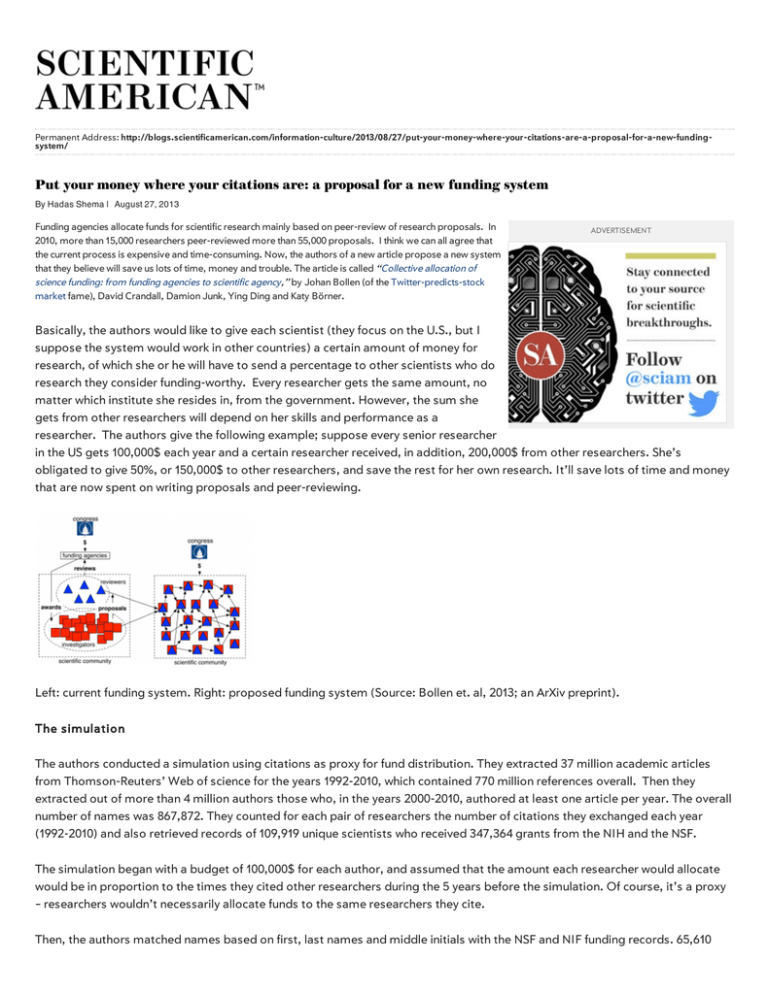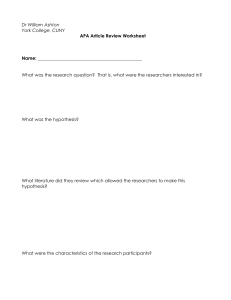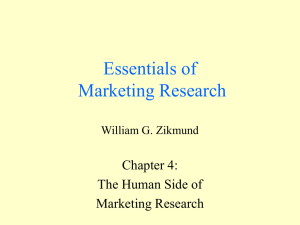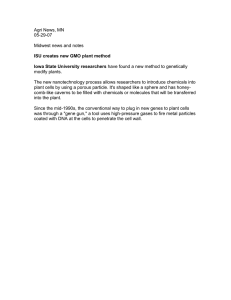Document 10768727
advertisement

Permanent Address: http://blogs.scientificamerican.com/information-culture/2013/08/27/put-your-money-where-your-citations-are-a-proposal-for-a-new-fundingsystem/ Put your money where your citations are: a proposal for a new funding system By Hadas Shema | August 27, 2013 Funding agencies allocate funds for scientific research mainly based on peer-review of research proposals. In 2010, more than 15,000 researchers peer-reviewed more than 55,000 proposals. I think we can all agree that the current process is expensive and time-consuming. Now, the authors of a new article propose a new system that they believe will save us lots of time, money and trouble. The article is called “Collective allocation of science funding: from funding agencies to scientific agency,” by Johan Bollen (of the Twitter-predicts-stock market fame), David Crandall, Damion Junk, Ying Ding and Katy Börner. ADVERTISEMENT Basically, the authors would like to give each scientist (they focus on the U.S., but I suppose the system would work in other countries) a certain amount of money for research, of which she or he will have to send a percentage to other scientists who do research they consider funding-worthy. Every researcher gets the same amount, no matter which institute she resides in, from the government. However, the sum she gets from other researchers will depend on her skills and performance as a researcher. The authors give the following example; suppose every senior researcher in the US gets 100,000$ each year and a certain researcher received, in addition, 200,000$ from other researchers. She’s obligated to give 50%, or 150,000$ to other researchers, and save the rest for her own research. It’ll save lots of time and money that are now spent on writing proposals and peer-reviewing. Left: current funding system. Right: proposed funding system (Source: Bollen et. al, 2013; an ArXiv preprint). The simulation The authors conducted a simulation using citations as proxy for fund distribution. They extracted 37 million academic articles from Thomson-Reuters’ Web of science for the years 1992-2010, which contained 770 million references overall. Then they extracted out of more than 4 million authors those who, in the years 2000-2010, authored at least one article per year. The overall number of names was 867,872. They counted for each pair of researchers the number of citations they exchanged each year (1992-2010) and also retrieved records of 109,919 unique scientists who received 347,364 grants from the NIH and the NSF. The simulation began with a budget of 100,000$ for each author, and assumed that the amount each researcher would allocate would be in proportion to the times they cited other researchers during the 5 years before the simulation. Of course, it’s a proxy – researchers wouldn’t necessarily allocate funds to the same researchers they cite. Then, the authors matched names based on first, last names and middle initials with the NSF and NIF funding records. 65,610 names matched, and they compared the actual funding for 2000-2010 to the funding predicted. The correlations were R = 0.268 (Pearson) and Spearman p=0.300. The authors emphasize that their proposal funds people rather than projects, which allows researchers more freedom than the current system. They suggest that perhaps researchers would be forbidden to contribute to their close collaborators, advisors and so forth, and that funding decisions would remain secret. I don’t know if those suggestions can stop researchers from creating “research cartels” where two researchers or more exchange funding, but we’ll cross that bridge if and when we get there. This is one way to turn the “citation economy” into an actual, money-based one. Bollen predicted in his 14th International Society of Scientometrics and Infometrics Conference (ISSI) keynote that prominent researchers would become funding agencies themselves. Imagine a world with way less grant proposals to write! It’s an intriguing concept, but I doubt governments would allow it (JUST GIVE THEM MONEY??!!) Johan Bollen, David Crandall, Damion Junk, Ying Ding, & Katy Boerner (2013). Collective allocation of science funding: from funding agencies to scientific agency ArXiv arXiv: 1304.1067v1 About the Author: Hadas Shema is an Information Science graduate student at Bar-Ilan University, Israel. She studies the characteristics of online scientific discourse and is a member of the European Union’s Academic Careers Understood through Measurement and Norms (ACUMEN) project. Hadas tweets at @Hadas_Shema. More » The views expressed are those of the author and are not necessarily those of Scientific American. Scientific American is a trademark of Scientific American, Inc., used with permission © 2013 Scientific American, a Division of Nature America, Inc. YE S ! Send me a free issue of Scientific American with All Rights Reserved. no obligation to continue the subscription. If I like it, I will be billed for the one-year subscription. Email Address Name Continue Advertise About Scientific American Subscribe Special Ad Sections Press Room Renew Your Subscription Science Jobs Site Map Buy Back Issues Scientific American Network Terms of Use Products & Services International Editions Privacy Policy Subscriber Customer Service Travel Use of Cookies Contact Us




